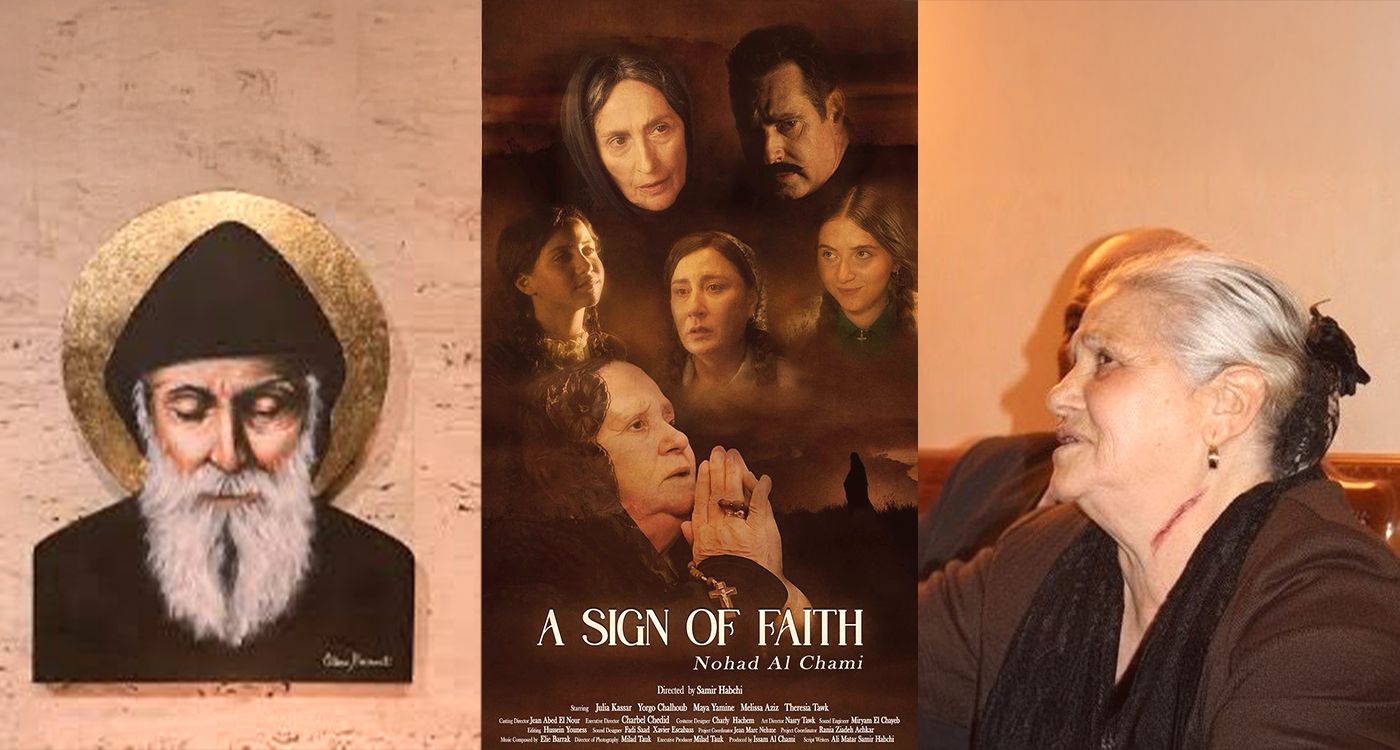
It was a bold choice to conclude a pilgrimage with a movie screening. Yet, these two days in Annaya ended with the projection of A Sign of Faith – Nouhad el-Chami in an almost empty theater. This was a logical, almost inevitable continuation of the inner journey attendants had just undertaken. A final station, in images and silence. A confirmation.
Just a few hours earlier, an Israeli strike on the southern suburbs of Beirut had once again reminded everyone of Lebanon’s wounds, a land both sacred and divided. And yet, it is from this very country that Saint Charbel emerges, the silent hermit who became a saint of miracles, transcending all boundaries of color, race, religion and nationality.
It is often said that miracles happen in silence. They are neither loud nor spectacular. They slip between things, seeping into the pores of life. To see them, one must have walked, prayed, doubted, fallen perhaps, but journeyed nonetheless. A Sign of Faith – Nouhad al-Chami tells that story. A miracle, yes. But more importantly, a journey, a cross and maybe, a form of merit.
Watching the film at the end of a two-day pilgrimage to Annaya changes everything. The movie, in itself, is surely moving. But after two days of confessions and masses, all gazes turned toward the same place, the tomb of Saint Charbel, which presents itself as an answer. Not a conclusion, but a confirmation, a certainty. Yes, Saint Charbel works miracles. Yes, he continues to act.
Directed by Samir Habchi and co-written with Ali Matar, the film recounts the true story of Nouhad al-Chami, portrayed by Julia Kassar and Maya Yammine. Alongside them, Yorgo Chalhoub, Melissa Aziz and Theresia Tawk deliver performances that perfectly align with the tone of the narrative. Nouhad is a simple, devout woman who suffers a stroke that leaves her paralyzed. Medicine gives up. Her body gives in. And in that abandonment, a surge, an apparition. Two monks, one silent, the other acting. A nocturnal operation, invisible to others but tangible in her flesh. She wakes up and walks. The doctors don’t understand. The skeptics sigh. The believers, however, know.
Nouhad suffered her entire life. Married off at a young age in a patriarchal society that imposed silence and submission on women, she endured beatings, humiliation and erasure. Her mother-in-law broke her down, slowly, day after day—a daily, inhuman violence. She bore 12 children, worked tirelessly, never complained, never renounced her faith. As a young girl, she saw the Virgin Mary in her dreams every night. She already had a devotion to Saint Charbel. She wanted to name her first son Charbel, but her husband refused and she had to obey. At the time, arranged marriages were the norm—a girl promised to a cousin or a neighbor’s son without being asked for her opinion. That same society, still harsh to many women today, left her with no escape.
The film is marked by the violence of the blows she endured, though her body bears no visible scars on screen. Before the miracle, there is the fall. Before the light, a long journey through the night. And this final relief, this ultimate grace, becomes all the more overwhelming—a gift from Saint Charbel, a celestial recognition for having endured everything without hatred, without faltering, without doubting. A compensation, a reward? This is where the film draws its strength: it does not seek to convince. It does not try to prove anything. It simply tells a story. The camera remains discreet. The music accompanies without imposing. And the light is striking. It oscillates between Rembrandt and Caravaggio (proportionally speaking, of course). A chiaroscuro light that sculpts faces, dramatizes silences. A light of contemplation, almost prayerful in itself.
There is no mystical hysteria here. What Samir Habchi captures is a silent, deeply rooted faith—an almost ordinary faith. A faith that sometimes hurts. A faith that demands.
The film poses a question without ever stating it outright, one that lingers long after: Does one have to deserve a miracle? Is it reserved for those who have prayed all their lives? For those who offer their suffering with humility? We don’t know. And maybe the answer isn’t in merit. Perhaps it lies in surrender, in the ability to place one’s pain in the hands of another, a saint, a God. Saint Charbel.
The film does not show him directly. It allows him to appear. A silent hermit, dressed in black, his face often hidden in the shadow of his hood. He does not need to speak. His presence is enough. They call him the “Doctor of Heaven.” He does not heal only bodies, he soothes souls, eases hearts and pushes back doubt. And in Annaya, he is everywhere. In the warm stones. In the faces tight with faith. In the silence of the crypt. He is not just a memory—he is here. His tiny cell at the hermitage remains untouched. He slept on a simple straw mattress placed directly on the ground. A radical, chosen austerity.
Inside the church, his portrait is lit by a flickering candle. An old monk prays, eyes closed, lips barely moving. In the small museum, crutches and thank-you letters pile up—material proofs of the immaterial. Outside, the cedar tree stands watch. It has witnessed so many tear-streaked faces. So many whispered promises. So many hopes entrusted to the night. Annaya is not just a setting, it is a mystical space. A suspended place. One climbs up to it as they would ascend an inner mountain. Each step is a prayer, each breath is a surrender. Up there, something unravels and thoughts settle. Pain finds another voice and sometimes, one begins to see. Not with the eyes, but with the soul. To see, finally.
The film, in its simplicity, aligns with this atmosphere. It does not impose, it accompanies. It does not seek to shock or to force emotion, it rather allows the miracle to unfold, similarly to Annaya. It leaves the audience free, to believe, to doubt and to open up. In the final scenes, as Nouhad recounts her dream, her mysterious operation, tears rise without warning. Not because it is sad, but because it transcends and forces a reconsideration of one’s certainties. The theater is nearly empty. A few scattered spectators. A country suspended between terror and light. And yet, in this silence, one sense a presence, peace, something else.
Since Annaya, one sees Saint Charbel everywhere, in the little things: a light that falls just right, a pain that eases, an intuition that illuminates. Perhaps a miracle is not always a spectacular healing. Perhaps it is simply a heart that starts believing again, fear that dissipates, peace that returns. And if that is the case, then yes, A Sign of Faith is a miraculous film.
When the lights come back on, you say nothing. You just know. Something happened. This was not just a movie. It was grace, like the pilgrimage to Annaya.





Comments